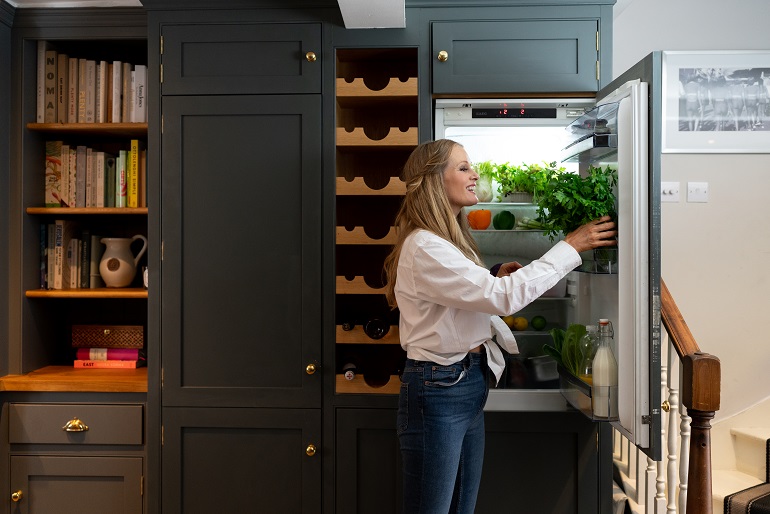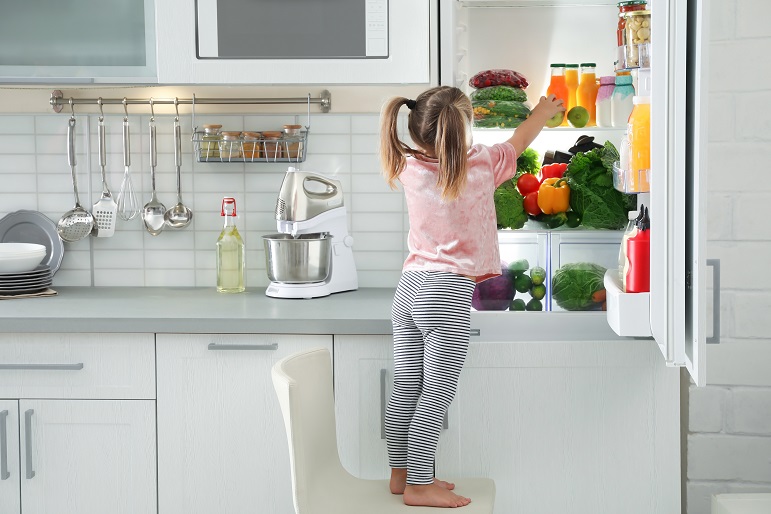A little condensation in your fridge is normal. In fact, many fridges have a drain hole to let this water run out.
Condensation only becomes a problem if it starts pooling or freezing, rather than draining away. Don’t worry, though – there’s often a simple fix for this that you can try yourself.
So let’s get into the reasons for fridge condensation and how you can stop excess water building up.
How fridge condensation forms

Have you ever had water droplets forming on the inside of your windows? That’s because of water vapour in the air, which becomes liquid when it touches the cold glass.
And the same thing happens in a cold fridge – water vapour in the air condenses and runs down the inside surfaces. That’s expected, especially when there’s a lot of water in the air. So don’t be surprised if your fridge has more condensation when the room is humid.
Most modern fridges have a drain hole that stops condensation pooling at the bottom. It’s usually behind the salad or crisper drawer. But if your fridge is a few years old, it might not have this feature.
When condensation becomes a problem
So when should you start worrying about fridge condensation? Here are some signs that it’s becoming a problem:
There’s a pool of water at the bottom of the fridge
- Water is leaking from the front door
- You find moisture inside food packaging in the fridge
- Ice is building up on the back wall
- The fridge has a damp or musty smell inside
These problems don’t always mean there’s a fault with your fridge. You might be able to fix them with a little adjustment and good maintenance, which we’ll explain next.
How to fix excess fridge condensation
Before you decide your fridge is broken, there are some other causes of condensation you can look at. Thankfully, these are easy to solve yourself – you don’t need any tools or technical know-how.
Unblock and clean the drain hole

Most fridges today have a drain hole, usually behind the salad drawer. Check your user manual if you’re not sure.
If water’s puddling at the bottom of your fridge, the drain hole might be blocked. Here’s how to unblock it:
- Turn the fridge off at the mains
- Take out any drawers and all the food
- Mop up the excess water and take off the drain hole cover (if there is one)
- Use the unblocking tool that came with your fridge to remove any food or grease
- Replace the drain hole cover and turn the fridge back on
If you don't have the unblocking tool, you can use a cotton bud, pipe cleaner or drinking straw instead. To find out more, see our advice on how to clean a fridge drain hole.
Check the fridge door seals
For your fridge to stay cool inside, it needs a tight seal. You can see this rubber seal around the edge of the fridge door.
If the seal gets damaged or comes loose, warm air will be able to get in. And this will lead to more condensation.
There’s a simple way to check if the seal is tight. Take a large piece of paper and close the door on it. If you can pull the paper out easily, the seal is probably loose.
Try this all around the seal, as it might be loose in just one area. This could happen if there’s something stuck in the seal, like food or grease. In that case, you can carefully wipe the obstruction away.
Otherwise, it might be that the seal needs replacing. And if you don’t get it sorted, your fridge will keep working harder than it should to stay cool. (That can lead to more serious faults and breakdowns).
Make sure the temperature is set correctly

If your fridge’s thermostat is set too low (cold), that can create extra condensation. Try setting it a little warmer and see if that helps.
Some fridges have a temperature setting in degrees Celsius. Others have numbers from 1 to 5 or 1 to 7. Remember that the higher number is the colder setting – so to make your fridge warmer, you want a lower number.
For more information, see our guide on the right temperature for a fridge.
Check that your fridge is balanced
Believe it or not, an off-kilter fridge can also cause too much condensation. Because if the fridge isn’t level, it can affect the coolant flowing and stop the door fully closing.
Ideally, the front of your fridge should be a little higher than the back – but it should be level from side to side. Grab a spirit level and check.
If your fridge is uneven, you’ll need to adjust the legs. You usually turn them clockwise to raise, anticlockwise to lower. You might need to empty the fridge and pull it out from the wall before leaning it back slightly. (Remember, fridges are heavy, so it’s best to have someone helping you).
Don’t overload your fridge

Your fridge is there to store food – but it isn’t like a cupboard. If you cram it full of food with no gaps for air to flow, it will have to work harder to keep the temperature at the right level. It will likely create ice in some areas, while other parts stay warm. And that’s a recipe for condensation.
So how full is too full when it comes to your fridge?
Try not to load it more than three-quarters full. Then there will be plenty of space for the air to flow and keep everything cool.
Clean up any spills
If something melts or spills in the fridge, it adds to the moisture. So the longer you leave it, the more condensation it will create. Also, food spills can get into the drain hole and cause a blockage (which will trap more water).
That’s why it’s important to mop up any liquid in the fridge as soon as you notice it. And try to keep spillable food in sealed containers that are less likely to leak.
Don’t put hot food in the fridge

Putting something hot in your fridge will make it work harder to stay cool. The hot food will also give off steam, adding more moisture – which will turn to condensation.
The solution is to always let hot food cool to room temperature before putting it in the fridge. To learn more, see this article from Bosch on whether you can put hot food in the fridge.
What to do if you’re still having issues with your fridge
If these fixes haven’t solved the problem of too much condensation in your fridge, there might be another issue. It could be that the fridge door isn’t closing properly, or the cooling system isn’t working right.
As fridges are electrical appliances, you’ll need a qualified engineer to fix any faults.
Our blog is loaded with more related articles

Fridge freezer tips
7 ways to make your fridge last longer
How long should a fridge last? Is it time to replace your fridge? We answer these questions and more.
Read more

Fridge freezer tips
What temperature should a fridge be?
It’s vital that your fridge is kept at the right temperature to store perishable food safely. Find out what temperature y...
Read more

Fridge freezer tips
Common fridge freezer faults and how to fix them
If your fridge isn't working properly, there are some things you can do to check for faults. Read our guide on common fridg...
Read more
